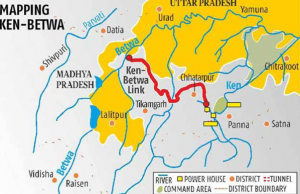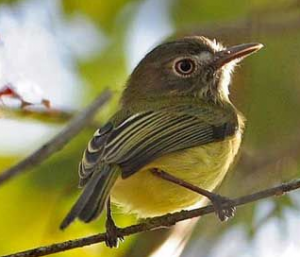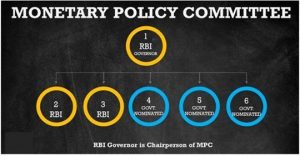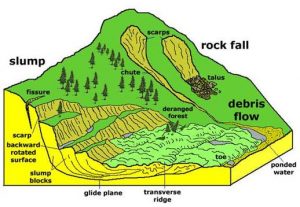Table of Contents
WATER RESOURCES & INTER-STATE RELATIONS
1. KEN-BETWA LINK PROJECT
THE CONTEXT: The Union Cabinet chaired by the Prime Minister has approved the funding and implementation of the Ken-Betwa inter-linking of rivers project.
What is the Ken Betwa Link Project?
- The Ken-Betwa Link Project is the first project under the National Perspective Plan for the interlinking of rivers. Under this project, water from the Ken River will be transferred to the Betwa river. Both these rivers are tributaries of the river Yamuna.
- The Ken-Betwa Link Project has two phases. Under Phase-I, one of the components — The daudhan dam complex and its appurtenances like Low-Level Tunnel, High-Level Tunnel, Ken-Betwa link canal and Powerhouses — will be completed. While in Phase-II, three components — Lower Orr dam, Bina complex project and Kotha barrage — will be constructed.

Significance:
- The project will provide annual irrigation of 10.62 lakh ha, drinking water supply to a population of about 62 lakhs and also generate 103 MW of hydropower and 27 MW solar power. The Project is proposed to be implemented in 8 years with state-of-the-art technology.
- According to the Ministry of Jal Shakti, out of the 6,017 ha of forest area coming under submergence of Daudhan dam of Ken Betwa Link Project, 4,206 ha of the area lies within the core tiger habitat of Panna Tiger Reserve.
- The Project will be of immense benefit to the water-starved Bundelkhand region, spread across the states of MP and UP.
- The project is expected to boost socio-economic prosperity in the backward Bundelkhand region on account of increased agricultural activities and employment generation. It would also help in arresting distress migration from this region.
National Perspective Plan (NNP)
The NPP comprised two components:
- Himalayan Rivers Development.
- Peninsular Rivers Development.
Based on the NPP, the National Water Development Agency (NWDA) identified 30 river links—16 under Peninsular Component and 14 under the Himalayan Component. Later, the river linking idea was revived under the then NDA Government in 2002. Ken Betwa Link Project is one of the 16 river linking projects under the Peninsular component.
Which are the clearances required for a river-linking project?
- There are 4-5 types of clearances are required for the interlinking of river projects.
- These are: Techno-economic (given by the Central Water Commission); Forest Clearance and Environmental clearance (Ministry of Environment & Forests); Resettlement and Rehabilitation (R&R) Plan of Tribal Population (Ministry of Tribal Affairs) and Wildlife clearance (Central Empowered Committee).
THE SOCIAL ISSUES & SOCIAL JUSTICE
2. WORLD INEQUALITY REPORT, 2022
THE CONTEXT: The report, titled ‘World Inequality Report 2022’, released by World Inequality Lab stated that India stands out as a poor and very unequal country, with the top 1% of the population holding more than one-fifth of the total national income in 2021 and the bottom half just 13%.
THE REPORT HIGHLIGHTS:
WEALTH INEQUALITY
- According to the report, the average household wealth in India is equal to 35,000 Euro or Rs 983,010, as per the data shared by the World Inequality Lab. “The bottom 50% own almost nothing, with an average wealth of 4,200 Euro or Rs 66,280)”.
- The report notes, “Indian income inequality was very high under British colonial rule (1858-1947), with a top 10% income share around 50%. After independence, socialist-inspired five-year plans contributed to reducing this share to 35-40%.
- Since the mid-1980s, deregulation and liberalisation policies have led to one of the most extreme increases in income and wealth inequality observed in the world. While the top 1% has largely benefited from economic reforms, growth among low and middle-income groups has been relatively slow and poverty persists.”
- The middle class is relatively poor, with an average wealth of only 26,400 Euro or Rs 723,930. This constitutes 5% of the total wealth. The top 10% of the population owns over 65% of the total wealth, with an average wealth at 231,300 Euros or Rs 6,354,070. The report claimed that the share of the top 1% in the national wealth stands at 33%.
GENDER INEQUALITY
- As per the report, “Gender inequalities in India are very high. The female labour income share is equal to 18%. This is significantly lower than the average in Asia (21%, excluding China)”. This particular value in India is one of the lowest in the world and only just higher than the average share in the Middle East, where the share of females in national income is at 15%.
CARBON INEQUALITY
- The report notes that the average person in the “bottom 50% of the Indian population is responsible for, on average, five times fewer emissions than the average person in the bottom 50% in the European Union and ten times fewer than the average person in the bottom 50% in the US.”
- “India is a low carbon emitter: the average per capita consumption of greenhouse gas is equal to just over two tCO2e. (tCO2e stands for tonnes (t) of carbon dioxide (CO2) equivalent (e)). These levels are typically comparable with carbon footprints in sub-Saharan African countries. The bottom 50%, middle 40% and top 10% respectively consume 1, 2, and 9 tCO2e/capita”.

THE GLOBAL PICTURE
- The report noted that income and wealth inequalities have been on the rise nearly everywhere since the 1980s, following a series of deregulation and liberalisation programs which took different forms in different countries.
- “The rise has not been uniform: certain countries have experienced spectacular increases in inequality [including the U.S., Russia and India] while others [European countries and China] have experienced relatively smaller rises,”.The report pointed out that in 2021, after three decades of trade and financial globalisation, global inequalities remain extremely pronounced.
RECOMMENDATIONS:
The report suggested levying a modest progressive wealth tax on multimillionaires. Given the large volume of wealth concentration, modest progressive taxes can generate significant revenues for governments.
THE ENVIRONMENT AND ECOLOGY
3. NEW SPECIES OF BIRD DISCOVERED IN SOUTH AMERICA
THE CONTEXT: A team of ornithologists from Brazil and Finland has discovered a cryptic new species of flatbill flycatcher living in the Amazonian lowlands.
THE EXPLANATION:
- “The new species is named the cryptic flatbill (Rhynchocyclus cryptos) after its remarkable morphological cryptic nature, which strongly contrasts with its high levels of vocal and genetic differentiation, two characteristics which probably allow for the sympatry with Rhynchocyclus guianensis throughout its range”.

- Flatbill flycatchers are members of the genus Rhynchocyclus in the exclusively New World family Tyrannidae.
- Four known species in the genus are distributed from southern Mexico to northeastern Bolivia, eastern Venezuela, and Brazil.
- Rhynchocyclus currently includes four species: the olivaceous flatbill (Rhynchocyclus olivaceus), the eye-ringed flatbill (Rhynchocyclus brevirostris), the Pacific flatbill (Rhynchocyclus pacificus) and the fulvous-breasted flatbill (Rhynchocyclus fulvipectus)”.
- “Two of these are monotypic (Rhynchocyclus Pacificus and Rhynchocyclus fulvipectus), and the other two are polytypic (Rhynchocyclus olivaceus and Rhynchocyclus brevirostris).” IUCN STATUS: LEAST CONCERN.
- “All are large-headed and flat-billed; with whitish eye-rings; upperparts olive-green; wings and tail dark brown with olive-green (edged feathers); lower parts grayish-green, striated with yellowish; centre of the abdomen yellowish; iris dark-brown; maxilla blackish; mandible white; and tarsi bluish-grey.”
THREATS:
- “The main threats for Rhynchocyclus cryptus are deforestation caused by the rapid progress of Madeira River, livestock farms, monocultures and implementation of large hydroelectric dams on the which affect the flow of sediments supporting seasonally flooded forests along its banks”.
THE ECONOMIC DEVELOPMENTS
4. RBI MONETARY POLICY
THE CONTEXT: The Monetary Policy Committee (MPC) of the Reserve Bank of India (RBI), based on an assessment of the macroeconomic situation and outlook, the marginal standing facility (MSF) rate and the bank rate remains unchanged at 4.25%. The reverse repo rate also remains unchanged at 3.35%.
THE EXPLANATION:
- According to the RBI Governor, the economic recovery that had been interrupted by the second wave of the pandemic was regaining traction but was not yet strong enough to be self-sustaining and durable. The downside risks to the outlook had risen with the emergence of Omicron and renewed surges of COVID-19 infections in a number of countries.
- Considering all these factors, the projection for real GDP growth is retained at 9.5% FY22 consisting of 6.6% in Q3 and 6.0% in Q4 of FY22. Real GDP growth is projected at 17.2% for Q1:FY23 and at 7.8% for Q2:FY23.
- Emphasising that cost-push pressures continue to impinge on core inflation, though their pass-through may remain muted due to the slack in the economy, also over the rest of the year, inflation prints are likely to be somewhat higher as base effects turn adverse; however, it is expected that headline inflation will peak in Q4:2021-22 and soften thereafter.
- Taking into consideration all these factors, CPI inflation is projected at 5.3% for FY22; 5.1% in Q3; 5.7% in Q4 of 2021-22, with risks broadly balanced.
- CPI inflation is then expected to ease to 5% in Q1:FY23 and stay at 5% in Q2:FY23.
Surplus liquidity
- According to the Governor, RBI has maintained ample surplus liquidity in the banking system to nurture the nascent growth impulses and support a durable economic recovery.
- “This has facilitated swifter and more complete monetary policy transmission and the orderly conduct of the market borrowing programme of the Government. The Reserve Bank will continue to manage liquidity in a manner that is conducive to entrenching the recovery and fostering macroeconomic and financial stability”.
- It has proposed to enhance the 14-day variable rate reverse repo (VRRR) auction amounts on a fortnightly basis in the following manner: ₹6.5 lakh crore on December 17; and further to ₹7.5 lakh crore on December 31, 2021.
- The Reserve Bank will also undertake Operation Twists (OT) and regular open-market operations (OMOs) as may be required for effective monetary transmission and anchoring of interest rate expectations in line with the evolving macroeconomic and financial conditions.
- To rebalance the liquidity surplus, it has now been decided to provide one more option to banks to prepay the outstanding amount of funds availed under the Targeted Long-Term Repo Operations (TLTRO 1.0 and 2.0) announced on March 27 and April 17, 2020.
Glossary:
What is Monetary policy?
Monetary policy refers to the use of instruments under the control of the central bank to regulate the availability, cost and use of money and credit.
Goals of Monetary Policy
- Price Stability along with growth
- The agreement on Monetary Policy Framework between the Government and the Reserve Bank of India in 2015 defines the price stability objective explicitly in terms of the target for i.e.,
(a) below 6 per cent by January 2016
(b) 4 per cent (+/-) 2 per cent for the financial year 2016-17 and all subsequent years.
Monetary Policy Committee:
The Monetary Policy Committee is a statutory and institutionalized framework under the Reserve Bank of India Act, 1934, for maintaining price stability, while keeping in mind the objective of growth. It is recommended by the Urjit Patel Committee in 2014.

Repo rate & Reverse repo rate?
- Repo rate is the rate at which the central bank gives loans to commercial banks against government securities. Reverse repo rate is the interest that RBI pays to banks for the funds that the banks deposit with it.
Headline inflation:
- It is a measure of the total inflation within an economy, including commodities such as food and energy prices (e.g., oil and gas), which tend to be much more volatile and prone to inflationary spikes.
CPI- Inflation:
Consumer Price Index or CPI is the measure of changes in the price level of a basket of consumer goods and services bought by households.
- The CPI captures changes in price level at the consumer level.
- Changes in prices at the producer level are tracked by the Wholesale Price Index (WPI).
- CPI can capture the change in the prices of services which the WPI cannot.
Open Market Operations:
- Open Market Operations refers to buying and selling of bonds issued by the Government in the open market.
- One of the Quantitative Tools: OMO is one of the quantitative tools that RBI uses to smoothen the liquidity conditions through the year and minimise its impact on the interest rate and inflation rate levels.
- Quantitative tools control the extent of the money supply by changing the Cash Reserve Ratio (CRR), or bank rate or open market operations.
5. NIGERIA’S DIGITAL CURRENCY ‘E-NAIRA’
THE CONTEXT: Nigeria recently became the first African country to introduce a digital currency. It joins the Bahamas and the Eastern Caribbean Central Bank in being among the first jurisdictions in the world to roll out national digital currencies. (Naira is the currency of Nigeria).
THE EXPLANATION:
What is a digital currency and how does it work?
- A digital currency is a means of payment or money that exists in a purely electronic form. Central bank digital currencies are issued and regulated by the nation’s monetary authority, or central bank, and backed by the government.
- They are different from existing electronic central bank money, which is provided by central banks but can only be used by banks and selected financial institutions. When financial institutions pay each other, they pay in reserves from accounts held with a central bank.
Reasons behind:
- Since oil prices crashed in 2014, the Nigerian economy has struggled to stay afloat—and so has the naira. The value of the naira has plunged roughly 160 percent against the dollar since 2012, a steep drop that has spiked inflation.
- Headline inflation in Nigeria is currently above 16 percent, and the official exchange rate hovers around 411 naira to the dollar (and at more than 560 on the street). The impact of these figures becomes clear when one considers that imports make up 65 percent of Nigeria’s total trade and that the naira-dollar exchange rate is central to most of these transactions.
- The eNaira was presented as a practical solution to these long-standing economic problems, even though it could never solve the problem of Nigeria’s unstable exchange rate and dwindling foreign reserves on its own.
SECURITY, DEFENCE AND DISASTER MANAGEMENT
6. LANDSLIDES IN CHAMUNDI HILLS
THE CONTEXT: The region has been getting heavy rainfall frequently. Due to rains which lashed the area near the Nandi Statue, meters around the earlier three landslides, has become a reason for worry to the District Administration as it has to take up massive scale works to restore the roads and the hillock to its original shape.
THE EXPLANATION:
- A team from the Indian Institute of Science (IISc) at Bengaluru had visited Chamundi Hill after the last landslide. Four major landslides have been reported on Mysuru’s Chamundi Hill since 2019.
- They studied the landslide pattern and took samples from faults, joints and bedding surfaces, which are contact points between rock and soil and contribute to landslides.
- The experts indicated that erosion had already set in and could be arrested only by not taking up any more construction activities as well as the movement of heavy transport vehicles.
- The Chamundi Hills are located 13 km east of Mysore, Karnataka, India. The name comes from the Chamundeshwari temple at the peak. The average elevation is 1,060 metres (3,480 ft).
Value Addition:
Landslides:
- Landslide is a rapid movement of rock, soil, and vegetation down the slope under the influence of gravity. It may be induced by natural agencies, e.g., heavy rain, earthquake, or it may be caused by human over- interference with the slope – stability.
- Man breaks rocks for constructing roads, railways, buildings, tunnels, etc. In such cases rocks become loose and landslide occurs.
- Earth flow, mass movement, mudflow, rotational slip, and avalanches are all examples of landslides.
- Landslides are rarely on a scale comparable to seismic or volcanic events. The intensity and magnitude of the landslide, however, depends on the geological structure, angle of dip of the slope, nature of sedimentary rocks, and human interaction with the slope.

The major causes of landslides are –
- Rainfall and Snowfall
- Earthquakes and Volcanic Eruptions
- Mining, Quarrying and Road cutting
- Loading by the construction of houses
7. CHOPPER CRASH IN TAMIL NADU
THE CONTEXT: The helicopter that crashed at Coonoor in Tamil Nadu leading to the deaths of the Chief of Defence Staff and 12 others, was a Russian-made Mi-17V5.
THE EXPLANATION:
- Chief of Defence Staff has died following a chopper crash in the Nilgiri Hills of Tamil Nadu that claimed the lives of 13 people. Four crew members and ten passengers, including the CDS, were on board the Air Force’s Mi-17V5 helicopter.
- The chopper crashed shortly after it took off this morning from an Air Force base in Sulur near Tamil Nadu’s Coimbatore. It was heading to Wellington in Udhagamandalam, also known as Ooty, where a Defence Services Staff College is located.
Features of Mi-17V5:
- It is a part of the Russian Mi-17 series, which can fly at high altitudes in complex weather conditions, be it in tropical and maritime climates or even in desert conditions.
- According to the Russian agency, the Mi-17V5s, domestically known in Russia as the Mi-8MTV-5, are designed for personnel transportation, and for carrying cargo internally or on an external sling. They are medium twin-turbine choppers useful in search and rescue operations and can be equipped with weapons.
- The larger family of Mi-17s are an upgrade from the Soviet-era Mi-8s. They are medium multipurpose two-engine turbo-shaft helicopters.
- However, But the Russian-made Mi-series choppers have been involved in several crashes over the past 10 years. As many as five accidents have taken place since 2010, claiming the lives of at least 42 people
Chief of Defence Staff (CDS):
- The Chief of Defence Staff of the Indian Armed Forces is the head and the highest-ranking officer of the Indian Armed Forces. The President of India is the supreme commander of the Armed Forces.
- The Chief of Defence is the military’s chief executive with operational and strategic authority over the defence forces and not its commander. He is a four-star officer.
History of the Chief of Defence Staff:
- Although the idea of the creation of the Chief of Defence Staff position has been floated post the independence of India, it was officially suggested through the recommendation of the Kargil Review Committee after the end of the Kargil War (which ended on July 26, 1999). Subsequent commissions such as the Naresh Chandra task force in 2012 and the Lieutenant General D.B. Shekatkar Committee in 2016 had also proposed their own versions of a Chief of Defence Staff position.
- On 2019 Independence day, Prime Minister announced the creation of the Chief of Defence Staff. A formal statement was issued by the Cabinet Committee on Security (CCS) on 24 December 2019 about the creation of the Chief of Defence Staff.
THE GOVERNMENT SCHEMES/INITIATIVES IN NEWS
8. EXTENSION OF PRADHAN MANTRI AWAAS YOJANA – GRAMIN (PMAY-G)
THE CONTEXT: The Union Cabinet, chaired by the Prime Minister has approved the proposal of the Department of Rural Development for the continuation of Pradhan Mantri Awaas Yojana – Gramin (PMAY-G) beyond March 2021.
THE EXPLANATION:
- The continuation of PMAY-G beyond March 2021 till March 2024 as per the existing norms to complete remaining houses within a cumulative target of 2.95 crore houses.
Benefits:
- The continuation of the scheme till March 2024 ensures that the remaining 155.75 lakh households within the overall target of 2.95 crore houses under PMAY-G would be aided with the construction of Pucca houses with basic amenities to achieve the objective of “Housing for All” in rural areas.
- As of 29th November 2021, 1.65 crore PMAY-G houses have been constructed out of the total target of 2.95 crores. It is estimated that 2.02 crore houses, which is almost equal to SECC 2011 database based Permanent Wait List will be completed by the deadline of 15th August 2022. Therefore, to achieve the total target of 2.95 crore houses, the scheme needs to be continued till March 2024.
ABOUT PRADHAN MANTRI AWAAS YOJANA – GRAMIN (PMAY-G)
Objective
To provide pucca houses to all who are houseless and living in dilapidated houses in rural areas by 2022.
Funding Pattern
- Under PMAY, the cost of unit assistance is to be shared between Central and State Governments in the ratio 60:40 in plain areas and 90:10 for Northeastern and hilly states.
- The unit assistance given to beneficiaries under the programme is Rs 1,20,000 in plain areas and Rs 1,30,000 in hilly states/difficult areas /Integrated Action Plan (IAP) for Selected Tribal and Backward Districts. Presently the NE States, States of HP, J&K and Uttarakhand and all 82 LWE districts are identified as difficult and hilly areas. The unit size is 25 sq.m including a dedicated area for hygienic cooking.
- The beneficiary is entitled to 90 days of unskilled labour from MGNREGA.
- The beneficiary would be facilitated to avail loan of up to Rs.70,000/- for construction of the house which is optional.
Target Group
- Identification of beneficiaries eligible for assistance and their prioritisation to be done using information from Socio-Economic and Caste Census (SECC) ensuring total transparency and objectivity. The list will be presented to Gram Sabha to identify beneficiaries who have been assisted before or who have become ineligible due to other reasons.
PRELIM PRACTICE QUESTION
Q1. Consider the following statements about Ken River:
- It is a tributary of the Son River.
- Raneh Falls is located on the Ken River.
- It passes through Panna National Park.
- Daudhan dam is being constructed across the Ken River.
Which of the given statements are correct?
a) 1 and 2 only b) 2 and 3 only
c) 2, 3 and 4 only d) All of them
ANSWER FOR 8TH DECEMBER 2021 PRELIMS PRACTICE QUESTIONS
Answer: D
Explanation:
sources of Hydrogen sulfide:
- Hydrogen sulfide is often produced from the microbial breakdown of organic matter in the absence of oxygen, such as in swamps and sewers.
- It also occurs in volcanic gases, natural gas, and some sources of well water.
